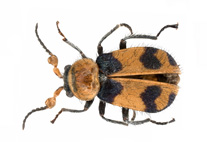Abstract
A new species of torpedo ray, Tetronarce cowleyi, sp. nov., is described from specimens collected from the southeastern Atlantic Ocean. The new species is placed in the genus Tetronarce based on a uniform dorsal coloration and absence of papillae around the spiracles. The new species is distinguished from its closest congeners, the North Atlantic Tetronarce nobiliana Bonnaparte, 1835, and southwestern Atlantic Tetronarce puelcha Lahille, 1926, by a combination of morphological characteristics including a shorter spiracular length, a proportionally greater head length as measured between snout margin and fifth gill openings, a proportionally greater preoral snout length, a uniform shiny black or dark gray dorsal surface, lacking any prominent markings, and a creamy white ventral color with dark edges in juveniles but fading with growth. Teteronarce cowleyi, sp. nov., is further distinguished from T. nobiliana by its more circular anterior disc shape (vs. relatively straight in T. nobiliana), fewer tooth rows (32/28 vs. 38–53/38–52 in T. nobiliana), greater mouth width (1.5–1.7 times as great as interorbital width vs. 0.5–0.6 times interorbital width in T. nobiliana), smaller distance between second dorsal and caudal fins (3.5–4.9% vs. 6.6–6.8% in T. nobiliana), and a clasper length extending nearly to lower caudal fin origin (claspers in T. nobiliana that extend only two-thirds distance between second dorsal and caudal fins). Teteronarce cowleyi, sp. nov., is known from Walvis Bay, Namibia to Algoa Bay, Eastern Cape, South Africa, at depths of 110 to 457 m.

